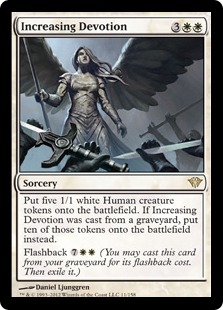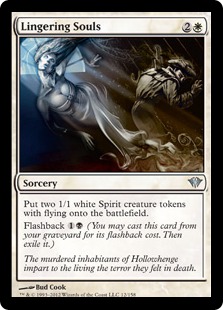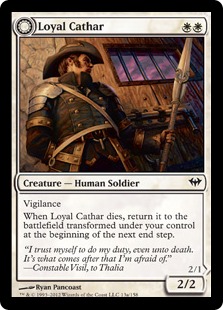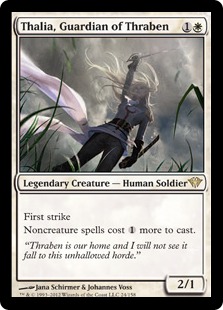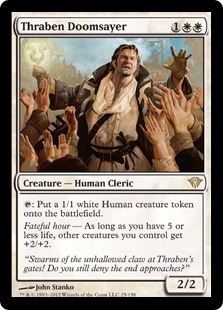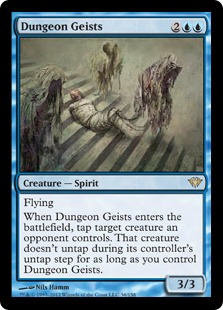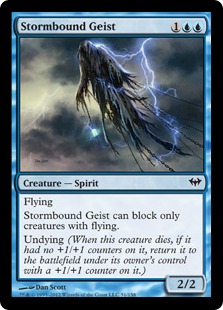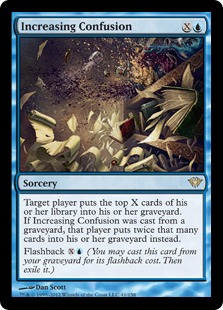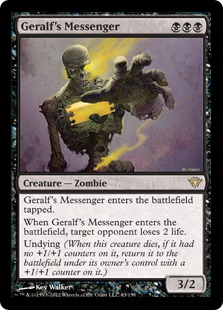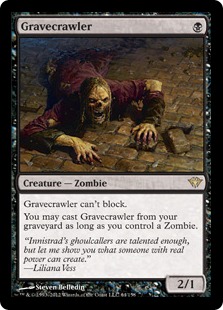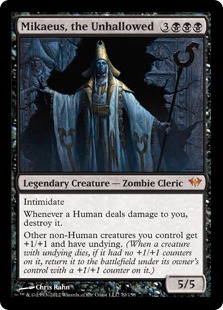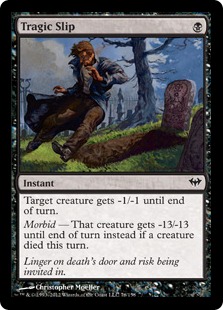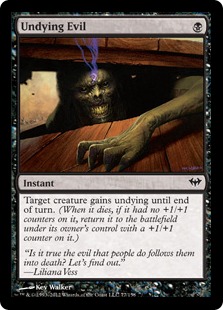Parnell: Welcome to the first edition of the Cube Chronicles Quarterly! Usman and I have decided to team up every three months to deliver the most in-depth cube review around, whenever a new set is released!
Usman: With every set comes a lot of interesting cube options, and Dark Ascension is no exception. In this article, Justin and I will be talking about how to best evaluate these new cards for different cubes.
We’ll start by going right into white and the cards that it brings to cube.
Parnell: Let’s talk about Increasing Devotion. This token maker looks like a more awesome Conqueror’s Pledge to me. Even if you’re drafting it without planning to flash it back, the upside is backbreaking as a top end for an aggro deck or a control finisher.
Usman: The interesting thing about its flashback is that because the tokens can help you stabilize, the card’s initial casting helps you to get to the flashback. That can’t be said of other cards like Army of the Damned whose tokens don’t really help you stabilize first, although it is generally good game when cast, provided you are able to untap with it (making it on the weak side of cube finishers). Thankfully, Increasing Devotion doesn’t have that caveat, but it seems relatively weak.
Parnell: It’s definitely not for all cubes, as the competition is tough for five at white.
Usman: True, cards like Gideon Jura, Elspeth Tirel, Reveillark, and Cloudgoat Ranger are generally staples in cubes because of their strong effect, but competition from those and other cards like Karmic Guide will likely keep Increasing Devotion out of many cubes. If cards like Geist-Honored Monk are on the outside, looking in, from many cubes, Increasing Devotion will be farther on the outside.
Parnell: A card I don’t see having any problem making it into most cubes is Lingering Souls. The problem is, is this a white card or a multi-colored card?
Usman: It all really depends on how people classify cards in their cubes; I’ve generally included cards like Kird Ape and Loam Lion in their respective multicolor sections to more accurately represent the role of those cards, and I will do the same with Lingering Souls. It’s a very solid card, but due to the insane competition in B/W, the classification method and size of the cube will likely determine whether this card makes it into many cubes.
Parnell: That can definitely be an issue, especially in a set where not one but TWO white-black cards are screaming to be included. I had one spot for two cards (suck it, Stillmoon Cavalier), and one is definitely black and white, so Lingering Souls ended up being “cheated” into my white section. Luckily I can justify this by honestly saying this card will get drafted a fair amount in decks that don’t have high hopes of flashing it back, making in mono-white enough for me.
Usman: It’s something that’s likely closer to Spectral Lynx than Kird Ape (generally useful even without the other color versus almost worthless without the other color), so the justification can work. I am considering it as black-white, which unfortunately may crowd Lingering Souls out of black-white because of the color combination being so strong (Vindicate, Sorin, and Desolation Angel are going to be the B/W stalwarts in cube). The funny thing being that if it had a white flashback of 1W or even 1U or 1R, it’d likely be an auto-include in cube because the competition isn’t as tight. Still, a really solid card, as it gives so much value from making so many tokens, and the flashback is quite reasonable.
Parnell: Agreed. Of course having or not having a token theme in your cube makes a difference too, as I think Midnight Haunting for Innistrad needs to come before adding Lingering Souls, based on exactly the issue you spoke about.
The next card is kinda white-black…as long as they kill him first. If you like value from your dudes (You’re reading a cube article! Of course you like value!), how can you not like Loyal Cathar?
Usman: I briefly talked about how white two-drops have gotten much better in my “2011 Cube Year in Review” article. A problem that cubes had initially was including too many WW cards, and thankfully, 2011 brought us Accorder Paladin, Porcelain Legionnaire, and Cloistered Youth for 1W, as they are all creatures that provide a lot of power to aggressive decks. This resulted in less pressure for white aggro decks to curve out. Lately, many cubes have taken out a lot of the protection knights like Silver Knight because of the great 1W creatures, and obviously, Loyal Cathar doesn’t offer much in the way of protection from colors, and vigilance is much worse than first strike on a relatively small body, but it offers a lot more in overall value from coming back as a Jungle Lion, which is a solid beater.
Parnell: As someone who has taken out all of the pro-Knights from his cube (sans Blood Knight), I think this guy is going to make it into tons more decks than those cards do on average. The protection is rarely relevant in real games and only lead to cards specifically drafted for sideboards. I know lots of cube owners don’t like to play with boards, especially at large events, so the number of times this guy is going to be relevant versus another 2/2 that costs WW is going to be very numerous.
Usman: It generally works very well with white aggro strategies in two ways: its transform not only provides another body for charging into battle, which is very nice when you just need to jam bodies onto the battlefield to get damage through, but it also provides for some mass-removal protection. Even its vigilance is useful for getting damage through while blocking in aggressive matches, and the opponent won’t be thrilled about giving you card advantage in aggressive mirror matches (a la “Why David Price Goes Second”). There’s even a minor synergy with Unhallowed Cathar being a Zombie, which is becoming a more relevant creature type in cube, something that will be discussed later.
Parnell: I feel like this is exactly what white wants, despite the casting cost being tough compared to recent cards like the one-mana-symbol white cards you alluded to earlier. Resilience is resilience, and Loyal Cathar delivers for every kind of cube. So far we’re three for three on agreeing on cards; how long can this hold up?
Usman: Thalia seems to fit in pretty well in white aggressive decks; many “hate bears” have not made the transition to cube well, either because of relative inefficiency (Leonin Arbiter, Glowrider, Samurai of the Pale Curtain, True Believer, Ethersworn Canonist), but Thalia looks like it should buck that trend. Generally, disruption for keeping an opponent in Stage 1 is useful in aggro decks (which is why Armageddon has been so heralded for white sections of cubes, although it’s obviously not necessary), and Thalia helps to do that while beating for two. It isn’t a curve-topper like Lodestone Golem, but she does bash while disrupting the opponent.
Parnell: I think I’m in the minority here, but I just don’t like her. I’ve never been in love with the Sphere effects in cubes, even though I will admit that she’s the best of the bunch when it comes to those cards. First strike helps her not suck in creature-based matchups, but she’s still outclassed by every three-toughness creature ever. It’s a tough card to maindeck when your opponents are playing with strictly better creatures, which is becoming more accessible to every color and archetype.
I can’t deny her power with a ‘Geddon, but even then her two power is a bigger deal to clock them.
Usman: Arguably, the “gets outclassed” argument can really apply for any two-drop like Loyal Cathar (you play Cathar; they play a Call of the Herd/Great Sable Stag), and while that’s certainly a bad scenario for when that happens, its role should be more to keep opponents from killing your team with mass removal. There are going to be matchups where she won’t pull her weight—she’s pretty loose against decks like U/G tempo that accelerate or bounce your guys with Aether Adept, Venser, et al. However her overall impact should be positive. Besides, if she’s bad in a particular matchup, isn’t that what your sideboard is for? Her overall impact versus other two-drops will determine how long she stays in cube.
Parnell: She’s the kind of card I’d like to have a redundant effect for, and a non-legendary, non-first striking version of her would probably make me change my tune. That way, you could copy her to increase the taxing effect. In a format where you can only ever have one of an effect like this, you want multiple in your deck to ensure you draw it before it doesn’t matter. It seems like she’ll be a card that gets sided out way too often after people play with her a couple times. But honestly, I hope I’m wrong, as I would love for that effect to be relevant.
Usman: One of the cards that looks like it could be a boon to white token-based strategies is Thraben Doomsayer. Unfortunately, it seems like this is a card that helps more in theory than in reality.
Parnell: Here is normally where I would reference how awesome Imperious Perfect is, but man hasn’t created a time machine for me to go back to 2007 yet. I just hate the “play my 2/2, cross my fingers, then get minimal value” vibe that I know will ultimately become this guy’s doom.
Usman: Creatures that tap to generate creatures like Master of the Wild Hunt and Bloodline Keeper are Limited all-stars because opponents tend to have little in the way of removal; whereas in Cube, that maxim doesn’t hold up as well. In Cube, the more successful “tap to make a creature” variants make up for their vulnerability by being high EV. If you get a token out of either creature, generally the card pays for itself (and if you get multiple tokens, then you’ve made out like a bandit). Something like Thraben Doomsayer doesn’t really have a high-expected value; even if you get two tokens out of Thraben Doomsayer, are you really doing that well?
Parnell: On the bright side, once you’re getting your ass stomped and your life total is telling you those 1/1 tokens you’ve been making haven’t helped in the slightest, he makes a 3/3! I just feel like the cube community has been fooled by this card in different forms over the years, and if history is any lesson (hint: it usually is), I would certainly approach with caution. Despite the one-mana discount, this guy is no Master of the Wild Hunt, and I feel like Master has been tutoring Lightning Bolts to the top of my opponent’s deck for the last three years. You can do better.
Usman: A brief note about the “fateful hour” mechanic is that while it may look like it has a useful upside, Thraben Doomsayer having a fateful hour anthem effect isn’t very good. Aggro decks that will best take advantage of the anthem effect will want to end the game in the early stages of the game, so unless you’re in the later stages of the aggro mirror or you’re running a lot of self-damaging cards in your deck like Jinxed Choker or Sulfuric Vortex, his anthem effect won’t really help your game plan either. Agreed, you can pass on this; sadly Doomsayers are 0 for 3 in cube.
Parnell: Blue isn’t particularly deep in Dark Ascension, but I’m pretty excited about Dungeon Geists. He seems so innocuous, but this guy is much closer to Sower of Temptation than people realize. He’s obviously not stealing a problematic creature, but taking one out of the game until they find a way to kill him is still excellent. He’s like a Faceless Butcher that actually butchers you rather than stands there with no face. Maybe I’m too high on this guy, but he seems completely awesome.
Usman: Lately, Evan Erwin has been a big fan of Dungeon Geists, and admittedly, I wasn’t a big fan of it in Cube until he started to talk about it as a better blue Faceless Butcher, and the Faceless Butcher analogy is pretty spot on. It’s mostly better than an exile effect because if the Dungeon Geists is killed, it doesn’t cause “enter the battlefield” triggers like Nekrataal’s to retrigger. Granted, it’s not all upside, as it lets creatures with static effects (like the New Phyrexia Praetors, Abyssal Persecutor) stay on the battlefield, but the overall effect is positive.
Tempo strategies have recently become more popular in blue sections, and Dungeon Geists fits that strategy like a glove, as it supplements creatures like Aether Adept, Venser, Shaper Savant, and spells like Repeal to deal with troublesome resolved creatures. The only thing that’s going to keep him out of many cubes is the hard competition at four mana in blue (the section of cube with cards like Jace, the Mind Sculptor, Deep Analysis, and Fact or Fiction), but I think it’s going to be pleasantly surprising, much like Frost Titan. Somnophore, welcome to modern-day creature power creep!
Parnell: I feel like not triggering ETB effects is going to be an even bigger deal than people realize. We’ve gotten to the point where every other creature enters the battlefield attached to an effect, and the Geist has a very reasonable body to go along with it. The fact that he is a creature rather than a non-creature should help his adaptation, for exactly the reasons you listed. This is my pick for cube sleeper in the set.
Also, upon further review, Dungeon Geists also has no face. Oh well, he’s still going to beat the crap out of you.
Usman: On the topic of creatures that beats face in the air, Stormbound Geist looks to do similar things…in common cubes. Sadly, I don’t think he’ll have a big impact in “regular” cubes, but it certainly has potential. Again, competition is so high in blue even with undying being so powerful a mechanic.
Parnell: Just comparing this guy to a Vendilion Clique makes him look like a joke. But I also expect him to pull his weight where the rares can’t play. Undying is a perfect cube mechanic, especially in C/U cubes where combat is more important. If this guy isn’t being blocked, you’re probably just fine bashing for two.
Usman: Increasing Confusion may be a card to keep tabs on. It’s not very good as a singleton mill card in a deck, as it requires too much mana and offers little if it cannot win a game (unlike something like Devil’s Play, which offers value even if not doming an opponent with initial casting + flashback). If we get to the point where a mill strategy is a consistently viable strategy, cube designers can consider Increasing Confusion, but today is not that day (and I don’t see that day coming any time soon, if ever).
Parnell: With Jace, Memory Adept seeing widespread play, Increasing Confusion is another piece to the puzzle. The card is clearly very powerful, but even a card that gives nine poison counters in a cube with no infect has no value. How many more high-quality mill cards have to exist before the strategy can be considered? And even when we reach that point, what are you as a cube designer sacrificing to have access to that strategy?
Not only that, but your play group has to want to play with mill cards as well as play a cube where they can be viably milled out of the game, getting rid of all of the sweet cards they drafted. I don’t think blue needs another win condition, which is the reason I don’t have Jace, Memory Adept in my cube. If you’re into milling, keep watch for more support, but otherwise file it away as un-cubable.
Usman: Much like in Innistrad, black looks like it got a lot from Dark Ascension. One of them is Geralf’s Messenger, a card that I think is going to surprise people in Cube. At first, I thought of it in the same way a lot of people did—as an awkward reverse Kitchen Finks, extremely hard to cast and a terrible blocker. It wasn’t until Kenny Mayer compared it to a different creature that I realized: Geralf’s Messenger isn’t a reverse Kitchen Finks; it’s a better Boggart Ram-Gang that damages for less on the initial swing but offers so much more upside because of undying.
Parnell: Kenny is 100% right on this one; the comparison to the beloved Finks is inaccurate. The only issue is the lack of support in black and the fact it can only be played in black, unlike Ram-Gang with access to two aggressive colors. When the Messenger is in play, there is no question he’s a better, more reliable clock. I can’t describe how much I want this card to be good. I mean, it is certainly good, but black is still lacking a couple of solid creatures to make black aggro fully supported without extending into subpar cards (Wretched Anurid and Blind Creeper, looking at you). The question then becomes: what does it take for him to be good now?
Usman: Black/X aggressive strategies have been getting better lately. Cubes have gotten Vampire Lacerator, Diregraf Ghoul, Bloodghast, and a host of other solid one-, two-drops, and it’s quickly catching up to other aggressive colors like red and white. The problem is that Geralf’s Messenger is going to be best in mono-black and nearly-mono-black strategies; there are a few cards that make people actively want to go into that strategy, like Gatekeeper of Malakir, but a lot of others like Lashwrithe, Corrupt, and Tendrils of Corruption are examples of cards that just don’t offer enough of an upside to pull people into that strategy. Granted, Gatekeeper is a fine card in B/X decks, as even casting it on turn 5 or 6 isn’t awful, and the same could be said of the Messenger; in testing, Messenger has been solid in B/X decks with enough fixing that his awkward mana cost isn’t that much of a liability. But if you do find yourself drafting Geralf’s Messenger in a B/X deck, make sure that your mana fixing is very good. Attempting to cast it in a deck with a Terramorphic Expanse or a Reflecting Pool as your only fixing will end in disaster, so don’t be too discouraged if it ends up being bad in those decks.
Parnell: The issue with the other black-heavy cards is they want to be in a deck that wants to slow the game down rather than speed it up, with the possible exception of Gatekeeper. Cubes are so close to being able to have a legitimate black aggro deck. All the other pieces are there, with the reach (discard), card advantage (Bitterblossom, Dark Confidant), an excellent land or two (Volrath’s Stronghold and Urborg, Tomb of Yawgmoth), and ability to scale upwards if the cards aren’t there in the draft. If only there were another two-power one-drop…
Usman: True, like Gravecrawler, which looks like it should be one of the best, if not the best, black one-drop in Cube. Black’s one-drops have generally lagged behind ones in other colors due to their drawbacks like Carnophage and Sarcomancy. While their drawbacks aren’t extremely relevant, the drawbacks still made them some of the worst out of the 2/Xs for one in Cube. Granted, they were still very good in black aggro decks, and having another one is always welcome for black aggressive decks, an archetype that’s just getting stronger in Cube. The interesting thing about Gravecrawler’s upside is that in Cube, your opponent doesn’t know how many Zombies are in your deck, unlike in Standard (and you would almost never play it as the only Zombie), so it puts the opponent in an awkward position with trades, making the opponent think “do I really want to trade with that if he’s just going to play Sarcomancy after?” Regardless of whether or not they care, it’s still very good as a 2/1 for B.
Parnell: The thing I like most about Gravecrawler is his upside going forward. Any reasonably costed aggressive Zombie only makes Gravecrawler better, and this just further cements black’s recursiveness alongside cards like Bloodghast and Bitterblossom. I previously said that I feel like this is going to be black’s Goblin Guide, while not being like Guide at all past the two power for one mana. It will be a backbone of black aggressive decks going forward. Even if you don’t have much Zombie support in your cube—and most people don’t or haven’t paid attention to that outside of the occasional Graveborn Muse—the fact that another two-power black one-drop exists is the important thing for redundancy.
On the other side of Gravecrawler, mana-cost wise, is a new black fatty, Mikaeus, the Unhallowed.
Usman: Black’s finishers are very competitive, with black getting arguably the best Titan and Kamigawa dragon, so black finishers have to be extremely good to compete with finishers like Grave Titan, Kokusho, and Massacre Wurm. The funny thing is that it may be one of the better black finishers as a curve topper, but it isn’t very good at that role, since it doesn’t provide a lot of value on its own; its value is almost completely derived from other creatures. I really want him to be a creature form of something like an Overrun or Eldrazi Monument, but his not giving other creatures evasion makes that analogy a big stretch.
Parnell: I can definitely agree that Mikaeus is in the top four for black fatties, but like you said, he seems more like an expensive enchantment that can attack/be killed. I think we can both agree Grave Titan is tops among the black fatties (who all happen to cost six), but where do you think he sits if we’re ranking them in order?
Usman: Mikaeus, the Unhallowed definitely ranks below Grave Titan and Kokusho, the Evening Star for sure. It does not have the potential board impact and damage output that Massacre Wurm has, but Mikaeus is at least much better than the weaker finishers like Visara, the Dreadful that people used to run in their cubes.
Parnell: I agree; that’s an easy upgrade to make. For me, he’s tied for third after Grave Titan and Massacre Wurm, neck and neck with Kokusho. That almost seems blasphemous to say, but they just don’t make creatures like they used to. Now, they’re much more ridiculous.
Usman: The Titans have pushed the boundaries of what define finishers, much like the Kamigawa dragons did years ago; if things are going at the current rate, the Kamigawa dragons could become obsolete in peoples’ cubes.
Removal is another one of those types of cards that have generally gotten better over the years (at least in non-white, aside from Path to Exile)—and Tragic Slip is something that may be worth a look, although it’s likely another card that loses out to existing competition.
Parnell: I think I want Disfigure over “The Slip” (should be its official name going forward), but after I thought about it, I’m not as sure. The Slip kills about 50% of all creatures Disfigure does, with the upside of killing everything it can target. This is very similar to the decision I had between Go for the Throat and Smother I had for my cube last year, and Go for the Throat ultimately won out for that reason. It should be clear this is a much tighter race, but I think I’m going to try and make room in my 540-card cube to at least give it a shot.
Usman: Smaller cubes may not have room for it, as many don’t run Disfigure, opting for the removal options like Snuff Out and Dismember that are able to kill a large variety of creatures. The potential is definitely there as a one-mana kill spell. The Slip doesn’t look like it’ll provide as much of a benefit from creatures dying en masse, as killing a creature post-combat is generally not what those types of decks want. They want to get blockers out of the way. Being able to get rid of blockers is a big factor with removal spells (which is why Crib Swap and Afterlife haven’t been very good in cube). Regardless, the potential is definitely there, and it may offer more than cards like Disfigure, the main thing being how often it kills Titans and other big creatures.
Parnell: In larger cubes, it’s certainly worth a shot, but as you said, when you get below 450, it’s really fighting with some amazing removal and may not do enough, often enough, to make the cut. Even in C/U cubes, all of that same removal exists at those rarities. You’ll probably have to look at numbers in your personal cube to see how it stacks up in efficiency to another potential cut.
Usman: Another card that is a combat trick with some upside is Undying Evil. Cards like Crystal Shard have been heralded in cubes because they allow players to recycle “enter the battlefield” triggers on cards like Manic Vandals and Nekrataal, and, at least in theory, Undying Evil allows players to do that while getting some value out of a creature trade / removal spell. Unfortunately, it can be difficult to utilize the recursion of creatures, as ultimately, the opponent is in control of your creature dying (unless you have ways to facilitate the death, via evoke or mass removal). It’ll work best in decks with a lot of ETB (enters the battlefield) triggers, like G/B midrange, but I don’t think it’ll be better than other black cards, as G/B likes its insurance policies strapped onto reanimation spells.
Parnell: This is one of the more interesting cards in the set for me. Undying as a mechanic is incredibly powerful, and I know in regular Limited, this card is going to be awful to play against but insane to play with. As Usman alluded to, the sheer number of ETB creatures in cubes currently is at an all-time high, and the number is only going up. Undying Evil reminds me of Unearth (the card) in that it lets you rebuy your creatures for little cost. This effect is completely unique, but even then, I’m not entirely sold on its application in decks.
Aggressive decks that might want it would play another creature in place of it, and control decks don’t have enough targets to waste a spot on it. That being said, this should make C/U cubes, as creatures are the damn near only ways to win in that format, and this is a hell of a trick.
Well folks, we’ve covered tons of cards today but still have even more to go! Join us for Part 2 of our Cube Chronicle Quarterly: Dark Ascension review where we’ll tackle red, green, multicolored, artifacts, and lands. Thanks for reading and see you soon!
@UsmanTheRad on Twitter
Usman’s blog featuring my powered & pauper cube lists (updated with Dark Ascension!): http://idratherbecubing.wordpress.com
Cube podcast that Anthony Avitollo and Usman co-host: The Third Power
Justin Parnell
@JParnell1 on Twitter
Official Facebook Cube Drafting Page: http://www.facebook.com/MTGCubeDrafting
Ali Aintrazi and my Custom Cube Project Facebook Page

